- Life top
- Daily Life
- Applying for LINE stickers
- Exhibition of Matsumoto-sensei
- Hana - Shiba-Inu
- Elec. handicraft & Akihabara
- Supermarkets in the area
- Takaido Civic Center
- Building a house
- Horrible dentists
- Judo therapy
- In an elderly care home
- Parties
- Cosplay bonenkai 2010
- Gainax cosplay bonenkai
- Friends from Gainax
- Friends from schooldays
- Party at Bar Espion
- Home party with cheese
- Music Life
- TARO Quartet
- Maeda-san - violin maker
- Chigusa Kindergarten
- Seniors playing music
- My viola debut
- Torakyo regular concert
- Toranomon Orchestra
- Four seasons
- Shrine visit of the New Year
- New Year´s postcard
- Snowfall in Tokyo
- Hina-matsuri and hina-dolls
- Sakura - cherry-blossom
- Sakura - what I missed most
- Fireworks Festival
- People
- Itakura - his adventurous life
- Naoto - his country life
Applying for LINE stickers
My Internet homepage creation career is probably one of the longest in the world. When I was living in Singaporen, Singnet began offering services as an Internet Service Provider in late 1994. Immediately thereafter I started building a website for my office. Then, in the summer of 1995, I launched my first personal homepage "Gourmet Paradise Singapore" introducing food stalls taken with the QV-10.
Nearly 30 years have passed since then. What I always kept in mind was to create html on my own, including programs such as CSS and PHP, without using home page creation software. Also, I made it my principle not to let my homepages accessible to commercials, and sticked to amateurism.
The time when I enjoyed making homepages the most was around the year 2000, when many people created their own personal homepages and used bulletin boards to communicate with their Internet friends.
After that, corporate-led SNS has become the mainstream of Internet use. I think it started with a blog. The design and functionality of interfaces for communication between individuals have also come to be made-to-order. When creating a homepage for a private group or a small company, most of them have a uniform design and contents according to the provided template, and the advertisement is placed there. For me, it's not a fun time any more.
Regarding the homepages of amateur orchestras and the exchange of information between members, even if it comes with advertisements, it is hard to beat the advantage of being able to use it for free, so I have no choice but to use the software provided. However, personally, I don't use SNS, I believe that email is enough for communication, and I rent my own mail server without using hotmail or gmail, which are commercially provided free of charge.


These are my draft stickers which were rejected by LINE judges as derivative creation suspected of jeopardizing the interests of copyright owner. |



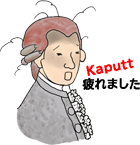 |
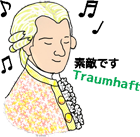


 |
However, among SNS, there is LINE, which is widely used in Japan. First, I was told to use it for communication within my family, and then I was told to use it for communication within the parts of the amateur orchestra, and I had no choice but to use it. Certainly, in order to ensure smooth communication among limited members, it is more convenient than email.
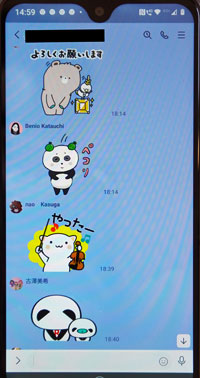 Sticker examples |
Individuals are not allowed to provide free stickers to LINE users. You have to charge at least 120 yen per set. Of course, LINE tries to make a profit from personal good will. Well, it can't be helped. However, what irritetes me is that the stickers are all childish and resembling so-called "yuru-chara", which are used for advertising by various companies and local governments in Japan. I am not happy, even if I think that childishness is the nature of modern Japanese culture.
Therefore, I thought that I would like stickers suitable for contacting classical music friends through LINE, so I decided to make my own with the theme of Mozart.
 Port of Mozart made by Barbara Krafft ( wikimedia) |
The character outlines, of course, refer to a typical Mozart portrait that is instantly recognizable to classical music lovers. However, Mozart lived in the 18th century, and the portrait was painted in 1819 after Mozart's death by the Austrian painter Barbara Krafft (1764-1825) referring to Mozart's portraits while alive. Even if Barbara had a copyright, it's long been expired. Wikimedia says the portrait belongs to the public domain and provides its images of various resolutions.
Composers belonging to the Vienna Classical School lived more than 200 years ago, so there is no way that portraits from the same period have copyright now in the 21st century. When articles are written about such composers, it is common practice to draw likenesses from several well-known portraits from which the common visual image of such composers has been created. The 2020 book I happen to have in my possession, "Comparing the Fees of Successive Composers", is a parade of such caricatures (see below). If this is allowed, why should my stickers, which only use outlines, be rejected as derivative creations where the ownership of the rights is not clear! Well, judges might have enough knowledge neither about classical music nor about copyright law, but this kind of "judging" is completely one-way, and there is absolutely no way to denounce the mistakes of the "judging" side. It's a sort of situation like Kafka's "Der Process".
I have looked around and found that there are quite a few testimonials on the Internet about how they managed to win their approval after being rejected by the screening process. Let's study now. It's a part of virtual game in the commercialized internet world.
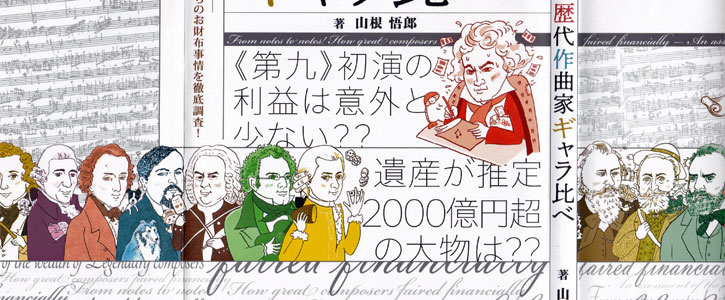


The stickers above were eventually accepted and these are my additional draft stickers (3 March). |

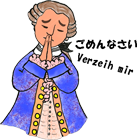

 |



 |


The second group was accepted as well and I decided to combine violin with LINE. (14 March). |



 |



 |


This is to add some more stickers to the violin series. (30 May). |



 |



 |